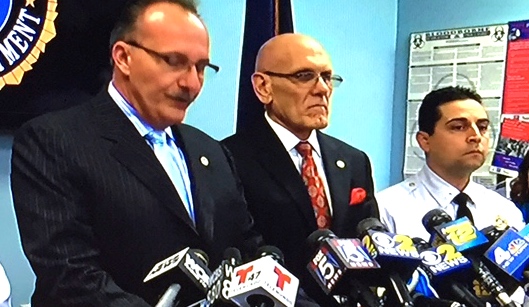Preliminary Metro-North Crash Report Void of Answers
The National Transportation Safety Board (NTSB) issued a preliminary report Monday on the Feb. 3 Metro-North crash that killed six people but doesn’t explain why the SUV driver moved forward into the oncoming train’s path.
The two-page report highlighted the main details in the moments leading up to the 6:26 p.m. crash at the Commerce Street crossing in Valhalla after the SUV driver, Ellen Brody of Edgemont, had the railroad crossing gate lower onto her vehicle.
Brody and five passengers in the first car of the train, the 5:44 out of Grand Central to Southeast, were killed when the collision sparked an explosion and fire. The crash also caused sections of the third rail to break apart, piercing the SUV and the underside of the train’s first car.
Despite the lack of clues in the communication, the report did state that Brody’s 2011 Mercedes 350ML was already in the crossing when one of the gates came down on the vehicle toward the back of the car.
It also stated that in addition to the gates, the crossing had warning lights that activate to warn motorists of an oncoming train.
“The SUV was stopped on the railroad tracks in the highway-rail grade crossing and was positioned in an easterly direction when the railroad crossing gates moved to the closed position,” one passage of the report stated. “Witnesses reported the driver of the SUV as being stopped in the crossing prior to the gates lowering. When the gate lowered, it struck the rear portion of the SUV after which the driver exited the SUV, looked at the back of the SUV, then got back in the SUV, drove forward (east), and was struck by the train.”
While the preliminary report did not mention how much time elapsed between the time that the gates lowered and the arrival of the train at the grade crossing, in a press briefing days after the crash, NTSB board member Robert Sumwalter said it took 39 seconds.
Other information that was previously dispensed during NTSB briefings also was included in the preliminary report. The train was travelling at 58 miles per hour–under the 60-mile-per-hour speed limit–when the emergency brake was pulled and the train’s horn was activated in accordance with regulations. The train’s recorder indicated that the emergency brake was activated four seconds before impact, about 300 feet from the SUV, and had decelerated to 49 miles per hour at the time of the collision.
The train and vehicle came to a stop 650 feet after they collided. Twelve 39-foot sections of third rail broke apart and were found inside the first rail car.
The NTSB will conduct a metallurgical examination of the third rail and samples of the lead train car’s interior will be examined for compliance with fire safety protection standards.
Metro-North estimated damage at about $3.7 million.
Earlier this month, the NTSB projected that its full investigation could take up to a year to complete.
On Monday, Rep. Sean Patrick Maloney (D-Cold Spring), who has written two proposed provisions to the Passenger Rail Reform and Investment Act (PRRIA), said officials need to be focusing on the safety of highway-rail crossings.
“Ninety-five percent of deaths involving trains actually happen at highway-rail crossings, and with hundreds of deaths at grade crossings each year, we must look at commonsense improvements at grade crossings — especially at high-hazard crossings we know are dangerous,” Maloney said in a statement.
Maloney’s two provisions to the PRRIA, which has been passed by the House Transportation and Infrastructure Committee, includes significant investments to improve rail crossings as well as positive train control.

Martin has more than 30 years experience covering local news in Westchester and Putnam counties, including a frequent focus on zoning and planning issues. He has been editor-in-chief of The Examiner since its inception in 2007. Read more from Martin’s editor-author bio here. Read Martin’s archived work here: https://www.theexaminernews.com/author/martin-wilbur2007/

